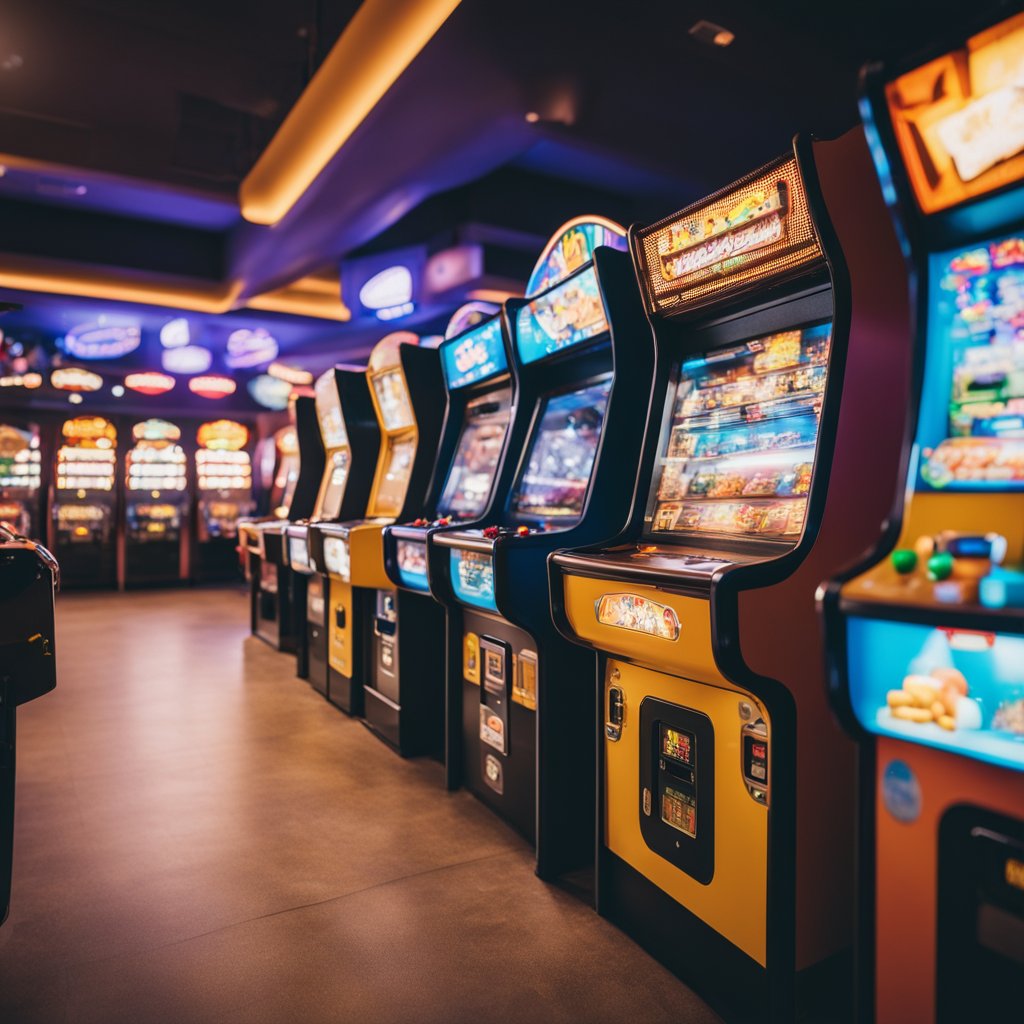As someone deeply immersed in the arcade world through my business, JUANminiDIY, where I craft custom wooden arcade sticks, I’ve often pondered how much money arcades actually make.
My journey with arcade gaming started back in grade school, around second grade, when my family would take trips to the mall. My two older siblings and I would spend hours playing our favorite games, and I even saved my school allowance just to get those precious minutes on the machines.
From those early days to college, where I shared countless gaming sessions with friends and classmates, I never imagined that my love for arcade gaming would evolve into a career.
Now, I get to create custom arcade sticks for gamers around the world, blending my passion with my profession.
But back to the question at hand: how do arcades make their money? What does it take to run one successfully in today’s gaming landscape?
Let’s dive into the business side of arcades and uncover what keeps them thriving.
A Brief History of Arcades
To understand the financial dynamics of arcades, we need to take a quick stroll down memory lane.
Arcades first exploded in popularity in the late 1970s and early 1980s, with games like Pac-Man and Space Invaders dominating the scene.
Back then, arcades were the place to play video games. If you wanted to game, you had to go out, and these venues were packed with eager players.
Fast forward to today, and while home consoles and online gaming have transformed how we play, arcades have adapted. They’re still around, and in some areas, they’re thriving.
However, they’ve had to evolve, becoming entertainment hubs that blend retro and modern gaming with social experiences like food, drinks, and events.
How Arcades Make Money
So, how do arcades generate revenue? It’s not just from the games themselves.
Let’s break down the key revenue streams that keep these businesses running:
1. Coin-Operated Machines
Classic arcade games like pinball, air hockey, and those iconic Dance Dance Revolution machines are still major attractions.
Many arcades utilize a pay-per-play model, where players insert coins or use pre-loaded cards to play.
On average, each game costs between $0.50 and $1.00, and a single machine can generate anywhere from $50 to $150 a week, depending on foot traffic.
In popular locations, that figure can be even higher. Multiply that by the number of machines in the arcade, and you can see how revenue begins to stack up.

2. Food and Drink Sales
Modern arcades often go beyond just games—they’ve become entertainment centers. Adding food and drinks, like a café or bar, is a savvy way to boost revenue.
Players tend to spend more time in the arcade if they can grab a slice of pizza or enjoy a drink between matches. For many arcades, food and beverage sales can account for a significant portion of their income.
Some arcades even offer full menus, and “barcades” that serve drinks alongside gaming have gained popularity in urban areas, attracting both gamers and social crowds alike.
3. Memberships and Subscriptions
With the rise of subscription models in various industries, some arcades have embraced this trend by offering memberships. These memberships might include perks like unlimited gaming during certain hours, discounts on food, or access to exclusive events.
This recurring revenue model helps stabilize income and fosters a loyal customer base. Players appreciate the value, and arcade owners enjoy a consistent stream of cash.
4. Events and Parties
Hosting events is another lucrative revenue stream for arcades. Birthday parties, corporate events, and gaming tournaments can draw large groups eager to spend on games, food, and drinks.
For these special occasions, arcades often offer packages that bundle food, games, and private space for a flat fee.
In fact, some arcades now host eSports tournaments, allowing players to compete for prizes while charging entry fees, which boosts profits through increased foot traffic.
The Challenges of Running an Arcade
Running an arcade is not without its challenges. One major hurdle is the initial investment. Arcade machines, especially newer or rare titles, can be expensive—some costing thousands of dollars each.
Additionally, maintaining and repairing machines can significantly eat into profits, particularly if a game is older or frequently breaking down.
Competition is another concern. With mobile and home console gaming more accessible than ever, arcades need to find ways to stand out. Many have pivoted to focus on offering unique experiences, such as themed nights, immersive games, or combining the arcade with other forms of entertainment like laser tag or escape rooms.
The Opportunities: Why Arcades Are Still Thriving
Despite these challenges, arcades continue to hold their place in the entertainment landscape. The nostalgia factor is huge—people love the idea of reliving their childhood or introducing classic games to the next generation.
Moreover, the rise of social gaming has given arcades a new angle. Unlike playing at home, arcades offer a communal experience—whether it’s competing with a friend in Street Fighter or teaming up for a round of Mario Kart.
Add in the appeal of events, food, and drink, and arcades become more than just gaming destinations; they’re social hubs.
Arcades aren’t going anywhere anytime soon. While they’ve had to evolve from their heyday in the ‘80s and ‘90s, they remain a beloved part of gaming culture.
With multiple revenue streams like coin-operated machines, food and drink sales, memberships, and events, modern arcades have found ways to remain profitable while offering something unique in the gaming world.
Whether you’re a fan or considering entering the arcade business, there’s no denying the draw of the arcade experience—and the potential for profit if done right.
So, How Much Money Can an Arcade Make?
The revenue potential for an arcade depends largely on its location, size, and the variety of experiences it offers.
Small, independently owned arcades might generate around $15,000 to $50,000 in revenue each month, with profit margins hovering between 20-30%.
For larger arcades or entertainment centers that offer food, drinks, and events, those numbers can be significantly higher, sometimes exceeding $100,000 per month.
Keep reading because in the next section, we’ll explore key insights into the arcade business, examining the financial factors that determine how much money arcades can make, from the cost of operations to profit margins and industry trends shaping the future of arcades.
The Business of Arcades
Now that we’ve covered the basics of how arcades generate revenue, it’s time to dive deeper into the financial side of the arcade business.
While nostalgia and social gaming play a big role in attracting players, there’s a lot more that goes into running a profitable arcade than just setting up machines and offering snacks.
Let’s take a closer look at what really drives the success of modern arcades.
Revenue Streams
Arcades have several ways to earn money.
The most common is through game fees where players pay to play games.
Many arcades still use the traditional pay-per-play model where coins or tokens are inserted into machines. Some modern arcades have shifted to card systems for payment.
Another revenue source is selling admission tickets that grant unlimited or time-limited play.
Food and beverage sales can also boost income, as players often enjoy snacks while gaming.
Hosting events or parties can further increase revenue, creating additional business opportunities.
Operational Costs
Running an arcade involves various operational costs that impact profitability.
Initial investment can be significant, with startup costs ranging from $65,000 to $130,000.
The largest expenses are arcade machines, costing between $6,000 to $9,000 each. Leasing or buying space also adds to these costs.
Maintenance of equipment is crucial, requiring regular checks and repairs.
Utilities, staff salaries, and insurance must also be considered.
Efficient cost management leads to better profit margins, so keeping operational expenses in check is essential.
Profitability Analysis
Profitability in arcades depends on balancing revenue and expenses effectively.
An arcade can make between $1,100 and $2,000 a week in profits when successful.
This figure varies based on location, size, and demographics. Industry standards suggest it can take 1 to 3 years to reach profitability.
Maximizing profit involves optimizing game selection, pricing strategies, and customer experience.
A diverse range of games appealing to different age groups attracts more customers.
Keeping players engaged and satisfied encourages repeat visits, which supports long-term profitability.
Arcade Gaming Market Overview
The arcade gaming market has undergone significant growth and changes.
In 2023, the global arcade gaming market was valued at approximately USD 4.04 billion.
It is expected to grow to USD 6.06 billion by 2031, with a compound annual growth rate (CAGR) of 5.20% from 2024 to 2031, according to Data Bridge Market Research.
Key Trends:
- There is a shift towards token or card-based systems instead of traditional coins. This change is particularly noticeable in the U.S. arcade industry, which generates about $3 billion in revenue annually, according to World Metrics.
Market Drivers:
- Advancements in technology and the introduction of new and innovative games are crucial growth factors.
- The popularity of technologically advanced products is increasing, as highlighted in a report by GlobeNewswire.
Summary of Market Value Growth (USD Billion):
| Year | Value |
|---|---|
| 2022 | 3.79 |
| 2023 | 3.98 |
| 2031 | 5.95 |
Understanding how much money an arcade makes can give you insights into the profitability and potential growth trends within the industry.
Evaluating Arcade Stick Products
When choosing an arcade stick, consider factors like design, technology, and pricing. It’s important to assess how these elements impact your gaming experience and budget.
Design and Ergonomics
Look for an arcade stick with a comfortable design.
The layout of buttons and joystick positions should feel natural for your hands. A good grip is crucial for long gaming sessions, so check the weight and size of the stick.
Consider the materials used, especially the build quality and finish. Durable materials mean your stick will last longer.
Some models offer customizable options, allowing you to adjust the layout or swap parts.
Evaluate the overall look. A visually appealing stick can enhance your enjoyment and fit your personal style.
Technology and Performance
Pay attention to the technology inside arcade sticks.
High-quality switches and joysticks ensure precise control, vital for competitive gaming. You want responsive inputs with minimal lag for seamless play.
Many models today feature compatibility with multiple platforms.
Check specs to ensure the stick works with your preferred gaming systems. Some sticks include features like turbo modes or custom key mapping to enhance versatility.
Consider checking reviews and performance benchmarks.
Real-world feedback often highlights strengths and weaknesses you might not notice at first glance.
Pricing and Market Position
Arcade sticks vary widely in price. Entry-level models might offer basic features at accessible prices.
Mid-range options usually add enhancements, like improved materials or better performance.
High-end models often come with advanced features and premium builds.
Decide on a budget before shopping and compare models within your range.
Evaluate what you get for the price. Some brands might offer excellent value, combining quality with affordability, while others target niche markets with specialized features.
Understanding the market position of different brands helps in choosing a product that aligns with your needs and expectations.
Marketing Strategies for Arcade Businesses
Engaging the community is vital for arcade success. Plan events like tournaments or themed nights to draw in crowds. Creating a vibrant atmosphere keeps customers coming back.
Consider loyalty programs. Offering rewards for frequent play encourages repeat visits. Discounts or free game credits after a certain number of visits are effective tactics.
Another strategy is online and offline advertising.
Use social media to reach broader audiences. Share photos, videos, or special offers to engage potential customers.
Locally, put up flyers or partner with nearby businesses for cross-promotion.
Regularly update your game selection.
Stay ahead by introducing new games, especially tech-focused ones like VR. This attracts tech-savvy gamers and justifies higher play rates, enhancing profitability.
Collaborate with local companies or other entertainment venues.
Build partnerships to host joint events or promotions.
This can improve community ties and increase footfall by up to 30% for your arcade, as mentioned in the information on how arcades with strong community ties can thrive.
Invest in a robust arcade marketing plan.
Understand your target audience and use appealing promotions to get their attention.
Make sure to keep players engaged and communicate the unique aspects of your arcade, much like the strategies discussed in this marketing guide for an arcade game room.
Networking is also key.
Attend trade shows to connect with suppliers and investors. Joining local business groups or online communities can help you find new opportunities and ideas for growth.

Arcade Stick Usage and Popularity
Arcade sticks are popular among both casual gamers and competitive players. They offer an alternative to standard controllers, providing a more authentic arcade experience.
Consumer Preferences
Many gamers prefer arcade sticks because of their design and functionality.
They offer a layout similar to classic arcade machines, which appeals to those who enjoy retro gaming. The joystick and buttons allow precise control, which is particularly useful in fighting games and other fast-paced genres.
Arcade sticks come in various styles and prices. Some are entry-level models, while others are high-end, featuring customizable buttons and responsive joysticks.
Customization options are a huge draw, allowing you to modify components to suit your preferences.
Competitive Gaming Influence
Arcade sticks play a significant role in competitive gaming, especially in fighting game tournaments.
Top players often use arcade sticks due to their accuracy and speed. The design helps execute complex moves more reliably than with a standard controller.
Major eSports events frequently showcase players using arcade sticks.
You might see them in action during competitions like EVO. Their durability and precision make arcade sticks a preferred choice for those serious about winning.
Operational Management for Arcades
Effective operational management in arcades focuses on key areas like staffing and training, and maintenance and upkeep.
Successful management ensures a smooth-running arcade that enhances customer satisfaction and boosts profitability.
Staffing and Training
When managing an arcade, hiring the right staff is vital. You’ll need friendly and knowledgeable team members who enhance the customer experience.
Staff duties range from handling game tokens to assisting with any technical issues on the floor.
Training is essential to ensure that employees understand their roles and can troubleshoot minor game malfunctions.
An efficient staffing schedule can help maintain productivity.
Offering ongoing training opportunities keeps your staff updated on the latest games and customer service techniques.
Regular performance reviews can also motivate employees and improve their engagement with customers. By prioritizing staffing and training, you enhance the overall experience in your arcade.
Maintenance and Upkeep
Regular maintenance of arcade equipment is crucial to keep games functional and safe.
Set up a frequent inspection schedule to identify minor issues before they turn into costly repairs.
Keeping track of wear and tear on machines helps you plan for replacements and updates.
Investing in high-quality cleaning supplies ensures your arcade stays clean, extending the life of your equipment.
Efficient upkeep involves checking for software updates for digital games.
Addressing cleanliness not only preserves the equipment but also creates a welcoming environment for customers.
A well-maintained arcade attracts more patrons and helps build a positive reputation.
Financial Planning for Arcade Ventures
Starting an arcade business involves careful financial planning. Begin by estimating your startup costs.
These can range from $100,000 to $500,000, depending on factors like location, size, and type of games you offer. Some key expenses include rent, utilities, gaming machines, and maintenance.
Key Costs:
- Rent and Utilities: Consider location and space requirements.
- Gaming Machines: Costs vary based on new or used units.
- Maintenance: Budget for repairs and regular upkeep.
Creating a detailed budget is crucial. You need to anticipate both fixed and variable costs, setting aside funds for unforeseen expenses.
Revenue Projections:
- Urban arcade game rooms’ monthly revenue can range from $10,000 to over $50,000. Annually, this means between $120,000 and $600,000.
- The specific figures will depend on factors like location and customer base.
Develop a financial plan that outlines various strategies, such as discounts during off-peak hours or special events, to attract more customers. Consider investing in marketing and advertising to build brand presence and attract foot traffic.
Revenue-Boosting Strategies:
- Special Events: Host tournaments or themed nights.
- Loyalty Programs: Encourage repeat visits with incentives.
- Merchandise: Sell branded items or souvenirs.
Your financial plan should also include ways to measure success. These can be tracking customer numbers or game popularity trends to adapt strategies as needed.

Trends and Innovations in Arcade Technology
In recent years, arcade technology has seen exciting innovations. One of the most significant trends is the integration of virtual reality (VR).
This technology immerses you in the game, creating a more engaging experience. VR arcades are becoming more popular, providing a new way to play that wasn’t possible in the past.
Another trend is the rise of augmented reality (AR) in arcade games. AR blends digital elements with the real world, enhancing the way you interact with games.
You may find these features in family entertainment centers, which are expected to become a $61 billion industry by 2027.
Arcade machines have also become more sophisticated with better graphics and sound systems. These machines are designed to attract players with their vibrant displays and immersive audio.
Developers are constantly pushing the boundaries to ensure that your gaming experience is thrilling and memorable.
Innovations in Arcade Sticks:
- Customization: You can now customize arcade sticks to suit your style and preferences.
- Wireless Options: Newer models feature wireless connectivity for more freedom.
- Advanced Components: Upgraded buttons and joysticks offer better responsiveness.
Customer Experience in Arcades
When you step into an arcade, the experience starts with the vibrant atmosphere. Bright lights, lively sounds, and a mix of classic and modern games catch your attention. This lively environment is designed to draw you in and keep you engaged.
Game Variety: You’ll find a wide range of games to suit different tastes. From traditional pinball machines to the latest virtual reality experiences, there’s something for everyone.
This variety makes each visit unique and exciting.
While navigating the arcade, you’ll notice that customer service plays a big role. Staff members are there to assist with game issues or questions and to ensure your visit is smooth and enjoyable.
Their friendliness and efficiency contribute to a positive experience.
Another aspect of arcades is the social interaction. Whether you come with friends or meet new people there, playing multiplayer games allows you to connect with others.
Sharing in the joy of winning or the frustration of losing can create lasting memories.
To enhance your experience even further, many arcades offer extra amenities like snack bars or lounge areas. Taking a break to grab a bite can recharge you for another round of games.
Loyalty programs are often available, rewarding frequent visitors with discounts or exclusive offers. This can add value to your visits and encourage you to return more often.
The Evolution of Arcade Sticks
Arcade sticks have come a long way since their early days. Over time, they have become more advanced, providing players with better control and an enhanced gaming experience.
Historical Developments
In the early days of arcade gaming, the controls were simple. Arcade sticks used basic components, like a joystick and a few buttons, to mimic the controls found on arcade cabinets.
These early sticks were designed primarily for durability because they had to withstand heavy use in arcades.
As home gaming grew, companies started making arcade sticks for consoles. During this period, arcade sticks became more sophisticated.
The focus was on replicating the arcade experience at home, which led to more accurate button arrangements and improved materials. You may remember classic models like the NES Advantage or the Sega Genesis Arcade Power Stick.
Modern Advancements
Today’s arcade sticks are packed with features. They use high-quality components like responsive buttons and precise joysticks to provide players with better control.
Some are even customizable, letting you swap out parts to fit your preferences. This customization can be crucial for gamers who want to optimize their setup.
Modern sticks also connect easily to multiple systems, offering plug-and-play compatibility. Some have wireless capabilities, reducing clutter and increasing flexibility for gaming setups.
With innovations aimed at enhanced performance, today’s arcade sticks continue to cater to both casual gamers and competitive players.
Legal Considerations for Arcade Businesses
Before opening an arcade, you must tackle several legal requirements. Understanding these can prevent problems later.
Business Registration: You should register your arcade as a legal entity, such as an LLC or corporation, to protect your personal assets. Each structure has different tax and liability implications.
Permits and Licenses: Many areas require specific permits to operate arcade games. Check with local authorities for any arcade-specific licenses you might need. You might also need a business license.
Zoning Laws: Ensure your location complies with zoning regulations. Different areas have different rules for commercial businesses, especially entertainment venues.
Health and Safety: Maintain a safe environment by adhering to health and safety standards. This includes having fire exits, proper lighting, and accessible facilities.
Insurance: Obtain liability insurance to cover potential accidents or damages. This is crucial to protect your business financially against claims and lawsuits.
Employment Laws: If you hire staff, comply with local employment laws, including minimum wage, workers’ rights, and safety protocols.
Taxes: Stay informed about tax obligations. This includes sales tax on games and prizes as well as income tax for the business.
Intellectual Property: Ensure you have the rights to use any copyrighted games and music in your arcade. Licensing agreements may be necessary.
Data Protection: If you collect customer data, comply with data protection laws to safeguard their information.
Stay Connected
Be sure to sign up for our email newsletter to stay in the loop with the latest articles, updates, and more.


